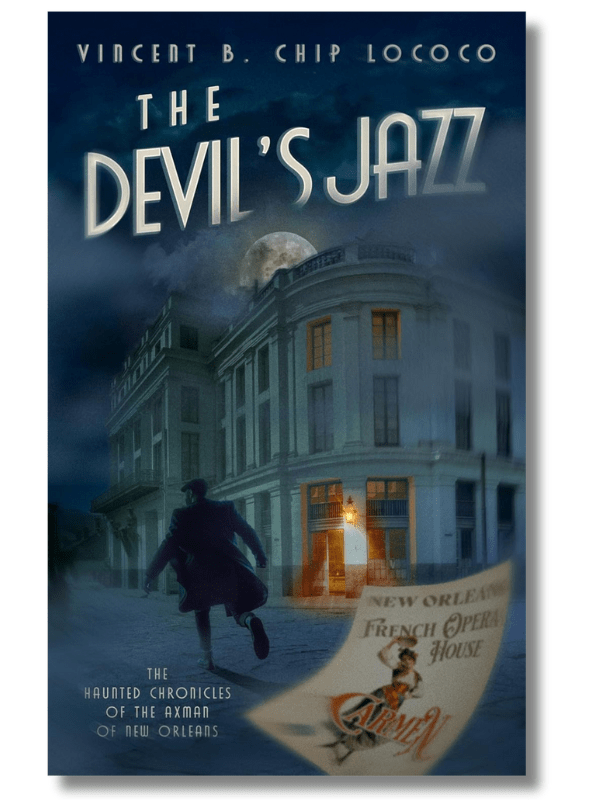The Devil’s Jazz
by Vincent B. “Chip” LoCoco
Genre: Mystery, Thriller & Suspense / Historical / Horror
ISBN: 9798986896335
Print Length: 332 pages
Reviewed by Peter Hassebroek
A compelling true-crime-style horror novel about taking down the infamous Axman of New Orleans
Set in 1918, The Devil’s Jazz is tightly tied to the actual events and people surrounding the Axman, New Orleans’s counterpart to Jack the Ripper. The main character is Giancarlo Rabito, a fictional detective based on a real person, who, at the start and on the advice of his doctor, retires. He’s fifty-three and will be missed as a liaison between the police and the Sicilian community.
A pair of images unsettle Giancarlo mere hours after he hands in his badge. First, a shadowy vision of the detective’s most regretful professional failure, the Cleaver, holding up his eponymous weapon. Then that evening at the opera, a program cover bearing a picture of the woman at the center of Giancarlo’s earliest murder case. An inauspicious start to retirement:
“He had to wonder if this would be how he would spend the rest of his days in retirement, haunted by old ghosts.”
Instead of getting spooked, Giancarlo is inspired to write about past cases. Not as a memoir but “in the style of a novel, immersing his readers into a world of mystery and intrigue.” Marguerite’s story is a fascinating one of ghostly circumstances, illustrating a key element of Giancarlo’s nature that will be tested later: “People began to call her the ‘Witch of the French Opera House.’ Giancarlo scoffed at the notion, and repeated his mantra: the murderer is just as real as the murdered.”
Giancarlo’s old case ruminations are interrupted when he learns of new attacks. And the targeting of Italian grocers and peculiar evidence of entry are too coincidental to not convince Giancarlo his nemesis is back. With a different weapon that leads to a moniker change.
Only Giancarlo’s former police colleagues aren’t convinced there is an Axman. They opt for easy conclusions (i.e. Black Hand mafia, family conflict) and quick arrests. Giancarlo undertakes his own inquiries with the help of a reporter—but to little avail. The attacks continue and the culprit becomes so brazen he pens a goading public letter with a bizarre jazz-related demand.
The Axman’s elusiveness eventually compels the retired detective to explore a theory adopted by others, that it’s not a man but a phantom. Giancarlo suspends his skepticism to venture into the Voodoo world where he experiences mystical and revealing encounters, both personal and Axman-related, including one with the aforementioned Marguerite. The supernatural is a captivating thread in an already engrossing historical mystery.
Throughout, the narrative is presented from multiple angles. The accounts of the Axman attacks shift in time and distance. For instance, the one on Joseph and Catherine Maggio begins with a brief scene of the Axman approaching his victims. It’s followed by another brief scene of Joseph’s brothers finding the couple, ending with: “What they saw would remain with them until the day they died.” The violence is sometimes described in a slightly editorialized, generally dispassionate style. Describing the assault after the fact rather than dramatizing it as it happens makes the novel less thriller or horror than crime fiction/true crime.
There is room shared for various aspects of New Orleans: its cultures, landmarks, history, people, and, of course, its music. The affection for New Orleans and its uniqueness is a standout feature of the novel. They provide a fuller, rounder picture of living in New Orleans in the midst of World War I, the Spanish Flu pandemic, and a serial killer. They also contrast the brutality of the Axman against the helplessness of Giancarlo and his fellow citizens.
The Devil’s Jazz is an intriguing historical mystery about an insider’s involvement to catch an erratic, jazz-obsessed, taunting serial killer that only the Crescent City could spawn.
Thank you for reading Peter Hassebroek’s book review of The Devil’s Jazz by Vincent B. “Chip” LoCoco! If you liked what you read, please spend some more time with us at the links below.
The post Book Review: The Devil’s Jazz appeared first on Independent Book Review.
